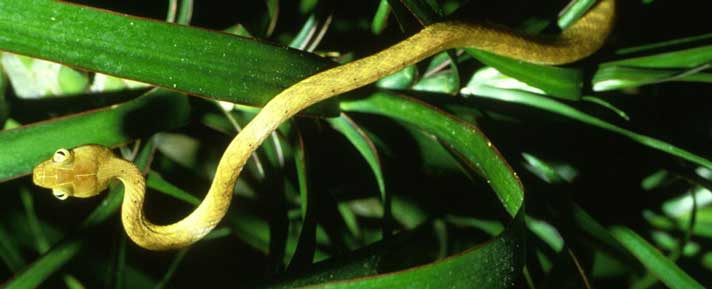Researchers want to expand the drop zones of drug-laced mice to further control the brown tree snake population on Guam.
Scientists with the United States Department of Agriculture want to resume the dropping of dead, acetaminophen-laced mice onto brown tree snake (Boiga irregularis) ravaged Guam, but are waiting for permission from the residents of the island nation to do so.

PD-USGov-Interior-FWS
Researchers want to expand the drop zones of drug-laced mice to further control the brown tree snake population on Guam.
Robert Gosnell, state director of the U.S. Department of Agriculture Wildlife Service, told the Pacific Daily News that the USDA is ready to start the drops on the island.
“The equipment is there, it’s a matter of people asking us to come in and do it,” Gosnell said.
In the past, the aerial drops, which involve dropping the dead, laced mice with streamers so they will catch in the treetops where the brown snake lives, have only been conducted on Andersen Air Force Base, which is Department of Defense property.
Want To Learn More?
USDA To Mice Bomb Guam In Effort To Reduce Invasive Brown Tree Snake Population
Invasive Brown Tree Snake On Guam Leads To Explosion In Spider Populations
Gosnell is hoping that the drop zones could be expanded to other regions on the island, but not in housing areas. So far, the drops have had some success. On five drops in a forested portion of the air force base, the population of the snake declined. On the fourth drop, fewer than 50 percent of the 117 snakes in the location remained. The rest had taken the bait and died.
A six month study into the use of the drug-laced mice noted that of 180 snakes captured on the island, the laced mice were effective in nearly 100 percent of the snakes.
The brown tree snake is an invasive species on Guam and is said to have made its way there by hitching a ride on an airplane or stowing away on a boat during the time of World War II. It is native to northern Australia, New Guinea, and the Solomon Islands. It averages two to four feet in length with the largest specimen captured on Guam measuring 10 feet. It has wreaked havoc on the local wildlife, and has decimated 10 of 12 native bird species to the point of extinction on Guam. With these birds removed from the ecosystem, the island's spider populations have gone largely unchecked, according to a study published in the journal PLoS One.


